In Humanities Teacher Billie Napoleon’s Historic Preservation class at Mid-Pacific Institute, high school students learn the value of buildings and places in their community through personal experiences. “The lessons have to be relevant so that the students care about the projects,” explains Napoleon. “We have to start with the personal, rather than first diving into preservation policy.”
This past semester, her students were exposed to historic cemeteries and invited to think about them as places of history and connection and as places worth preserving. Cemetery historian Nanette Napoleon was invited to give a special presentation to the class and helped provide context for this perspective. Students were tasked with an assignment: to visit the grave of a relative with a family member and to write a reflection about the experience.
Thanks to Billie and our collaborative partnership, HHF is pleased to share a few of these insightful essays below.* We applaud the ingenuity and resourcefulness of this lesson plan; how it enabled students to engage with a historic site safely and together with family members. Mahalo to Billie, Nanette, the students and their families!
[su_divider top=”no” size=”1″]
Cemetery Visit: Valley of the Temples (Kāne‘ohe, HI)
by Sydney Tsuruda
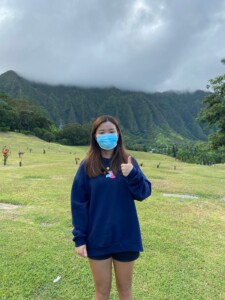 Overall, the Valley of the Temples Memorial Park is a very well manicured and maintained place. The site has a beautiful scenic view from every point. The Ko’olau mountains add to the amazing Hawaiian aesthetic and the abundance of native Hawaiian plant species contribute to the lush nature of the land. The cemetery is rather quiet and makes me feel a sense of tranquility and peace.
Overall, the Valley of the Temples Memorial Park is a very well manicured and maintained place. The site has a beautiful scenic view from every point. The Ko’olau mountains add to the amazing Hawaiian aesthetic and the abundance of native Hawaiian plant species contribute to the lush nature of the land. The cemetery is rather quiet and makes me feel a sense of tranquility and peace.
I went with my mom to visit her grandparents. She told a story about how she would often stay at their house in Palolo from time to time because growing up, she lived in Kāne‘ohe which was too far away from her friends (a majority of them lived on the other side of the mountains). So after school she would head over to her grandparents’ to hang out, then she would leave to meet up with her friends, and usually she would not head home to Kāne‘ohe until late at night which upset my grandparents a little.
By telling stories, we are able to remember a part of history, even if it’s only one person we are talking about. We are able to remember where we came from, how we became who we are today, and the influences that guided those around us, which in a way helped guide who we are as well.
Visiting cemeteries give us a glimpse of those who rest there. Both the deceased and the cemetery itself connect the past and present and preserving history is about remembering where we came from. Everyone can contribute to preserving a cemetery, whether that be merely visiting or helping to maintain them.
Hearing the stories my mother shared about my great-grandparents made me reflect on how much our lives differ (and also what we have in common). It was interesting to hear about my mom’s relationship with her grandparents and how they were a huge part of her life, like how my own are. When I was younger prior to moving to Hawai‘i, I wasn’t able to just go over to my grandparents house to hang out since my grandparents on both sides of my family live in Hawai‘i, so in that sense it differed greatly, but just hearing about how my great-grandparents took my mom and uncle to the beach and to eat shave ice gave me a great sense of appreciation of how I am able to experience what she had growing up with my own grandparents.
Visiting the cemetery was like walking around a sanctuary, full of agricultural life and beautiful scenery. I thought the cemetery was extremely rich with historical context. You feel peace and tranquility just by looking around at the different native Hawaiian plants and mountains. Wandering along the scenery were rugged-looking feral cats.
Hidden in the greenery was the Byodo-in Temple, a scaled down replica of the original Byodo-in Temple in Uji, Japan. This is an additional historical site because the construction of the building represents the history of Japan and Hawai‘i’s relationship. This structure tells a long history of Hawaiian demographics and where some of the people of Hawai‘i today came from, solidifying a piece of their Japanese heritage permanently to share with those around the world.
As we ventured further into the site, we discovered more wonders, including a very nice road, shaped like a heart, and in the center was a gravesite with a water fountain bordered by ginger and ti plants. It was the pinnacle of natural beauty!
As we circled around and left the Valley of the Temples, I felt as though I gained much more insight into cemeteries and my family history. Being able to share a moment with my mom created a deeper connection between not only us, but also between me and my great-grandparents, even though we’ll never meet.
I strongly believe we as the younger generation should do our best to preserve our historical heritage. This is not to say we can’t be progressive–preserving history allows us to see our origins and influences. We must learn from history’s mistakes and where we came from to not only better ourselves, but our society. We need our cultural identity that guides us with moral values to make the right decisions. Without preserving history, we would lose a part of our identity.
[su_divider top=”no” size=”1″]
My trip to O‘ahu Cemetery
by Kyle Chun
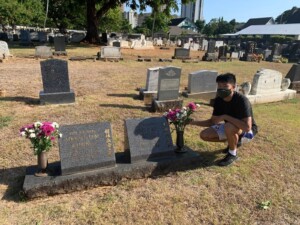 Today I went to the O‘ahu Cemetery in Nu‘uanu. My first impression of the site was that it is bigger than it seems. I also noticed that all kinds of people are buried there. I even noticed there were gravestones written in Hebrew. The cemetery is well maintained by the people who work there. I put flowers in the graves of Hong Chee Chung and Sook Ee Chung. I also put flowers in Alana Dung’s grave. The people who work at this cemetery get rid of old flowers and old food however, it is the visitors’ job to clean the grave of a family member.
Today I went to the O‘ahu Cemetery in Nu‘uanu. My first impression of the site was that it is bigger than it seems. I also noticed that all kinds of people are buried there. I even noticed there were gravestones written in Hebrew. The cemetery is well maintained by the people who work there. I put flowers in the graves of Hong Chee Chung and Sook Ee Chung. I also put flowers in Alana Dung’s grave. The people who work at this cemetery get rid of old flowers and old food however, it is the visitors’ job to clean the grave of a family member.
The cemetery adds a peaceful feeling to its environment. There are a lot of trees and it’s in a quiet neighborhood with gates surrounding the perimeter of the cemetery. The back part is more secluded so it’s quiet because there aren’t many cars driving by. You can see tall buildings in the background which gives it a city feel as well. There are also houses surrounding the site. 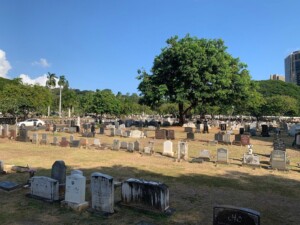 This site makes me feel peaceful and I feel like there is a lot of spiritual presence in the area. It also makes me feel curious to explore more about it. I saw graves from the 1800s, I saw graves of all different shapes and sizes and this made me wonder what are the backgrounds of the people laid to rest there.
This site makes me feel peaceful and I feel like there is a lot of spiritual presence in the area. It also makes me feel curious to explore more about it. I saw graves from the 1800s, I saw graves of all different shapes and sizes and this made me wonder what are the backgrounds of the people laid to rest there.
The story my mom shared to me was about my great-grandma, Sook Ee Chung. She was blind and only able to see shadows. In crowded places like Chinatown, she would cut in front of people without knowing better. One day, my aunty brought home from school square pieces of moldy bread that she had used for a science experiment. Each piece had been exposed to different variables like bread in sunlight, bread in darkness, etc. Sook Ee ate the bread and said it tasted like sourdough. My aunty thought that was funny; fortunately, Sook Ee didn’t end up getting sick. I hadn’t hear this story before and it gives me the impression that Sook Ee was very Chinese. She had a tough stomach and was used to eating anything! Although this was pretty humorous to my aunt, it felt normal to Sook Ee, and maybe some things weren’t as funny to her (because of cultural differences). Sook Ee could only speak Chinese and would only cook Chinese food. Maybe this is why she was detached from American culture and mannerisms.
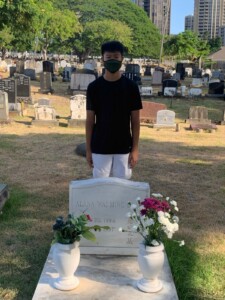 The telling of this story helps preserve a cemetery because stories are what bring significance to our ancestors. Stories are what we remember them by and it allows us to understand what they were like. Visiting a site is the way to preserve a cemetery because it can move you to care more about the people at the site. This means you will probably help to keep it clean and pay respect to the people who came before you. It is also important for preservation because cemetery visits can get passed down throughout generations as a family tradition. By going to cemeteries, you learn more about someone you may have never met before.
The telling of this story helps preserve a cemetery because stories are what bring significance to our ancestors. Stories are what we remember them by and it allows us to understand what they were like. Visiting a site is the way to preserve a cemetery because it can move you to care more about the people at the site. This means you will probably help to keep it clean and pay respect to the people who came before you. It is also important for preservation because cemetery visits can get passed down throughout generations as a family tradition. By going to cemeteries, you learn more about someone you may have never met before.
[su_divider top=”no” size=”1″]
My Visit to Valley of the Temples Memorial Park
by Chelsee Sawai
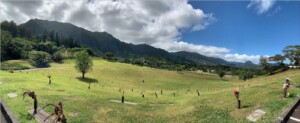
Today, I visited a family member who I, unfortunately never had a chance to meet. Her name was Stacey Garma and was my mom’s cousin who lived from 1966 to 2006. She is buried at the Valley of the Temples cemetery in Kāne‘ohe at the top of the hill near the highest temple. I had noticed my mom (Tasha) visit Aunty Stacey’s grave before, but I did not have a clear picture of who she was and what she was like. This assignment brought me closer to someone I never had a relationship with.
My first impression of the site is that it is lush with greenery and it has frequent visitors coming in and out of the entrance. As I stood there taking in the view from the top of the hill, the green that surrounded me was amazing–I could see a clear view of the beautiful Ko‘olau mountains. Across the mountains, there were trees everywhere and the grass was bright green, no dead patches anywhere in sight. The landscaping of the site is well maintained and I also saw a good amount of people visiting graves, doing their part to help maintain the cemetery. People would bring vases to the water faucet to rinse and refill them and place them near their loved ones’ graves. They were, including my family and I, placing fresh flowers in the vases and arranging them in an orderly manner.
This visit made me feel more sensitive and thoughtful about being at a cemetery for two reasons: knowing what I know about cemeteries and physically preserving them. From learning about cemeteries, I know that just being there and/or visiting someone you know who is buried there is the action of saving that cemetery. It’s one thing to write about it in class and talk about it, but to actually do what I am defending, acting on my my words, is a different feeling. When I began learning about cemetery preservation I was in front of an iPad screen; getting to learn more and take action on it in-person feels really good. Now, I have the experience of preserving cemeteries by visiting a cemetery through a screen and in real-life.
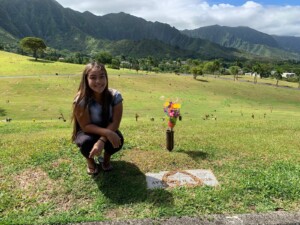 Aunty Stacy was my mom’s cousin, which is why my mom is the one who told me a story about her that emphasizes her character and who she was best. It happened when my mom was in 6th grade and Aunty Stacy just graduated high school. They were both in Kaua‘i to spend time with another aunty for the summer.
Aunty Stacy was my mom’s cousin, which is why my mom is the one who told me a story about her that emphasizes her character and who she was best. It happened when my mom was in 6th grade and Aunty Stacy just graduated high school. They were both in Kaua‘i to spend time with another aunty for the summer.
Aunty Stacy had over $1,000 in cash from her graduation party. Instead of spending it on herself, she told my mom, “I’m going to buy you new clothes.” My mom tried to refuse, knowing that the money should really be spent on Stacy’s future, but Aunty insisted. They were in a store and Aunty, holding up pieces of clothing, asked my mom, “What do you think of this? Do you like this?” and my mom would agree. Aunty started grabbing clothes, not even looking at the price tag, even though they were expensive. By the end of the trip, Aunty spent all her money having fun with my mom. Mom told me, “She would have loved you and you would have loved her.”
Hearing this story helped shape my impression of Aunty Stacy in a couple of ways: her personality and her capacity for love. She seemed like a lively and fun-loving person, with a huge sense of humor. These characteristics remind me of the family members I see every year on holidays and get along with very well. I feel she would have been just like a close family member to me. This story also allows me to assume that Aunty was someone with a big heart. She valued her family over herself and her selflessness is something I appreciate, even though I am “away” from her.
Telling stories helps to preserve a cemetery because it provides a description as to what type of person the deceased was. This gives motivation to go back and honor that person’s life. Although the person receiving these stories is unable to talk to and spend time with the deceased, the next best action is to listen with an open mind and heart. This will give an accurate picture of the loved one and is a way of passing on their legacy to future generations. Stories motivate us to honor and continue to remember that person. This can continue from one generation to the next, leading to more and more people visiting cemeteries and potentially help preserve them.
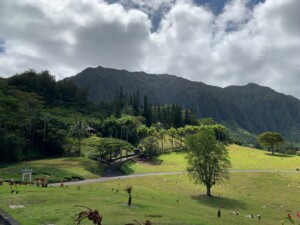 The preservation of cemeteries supports historic preservation because cemeteries are a part of history. The stories of people buried at cemeteries are what makes history; they are a part of it. Just like with any other historic site that we learn about and how they are preserved through community action, visiting a cemetery for this assignment was a way of supporting historic preservation without having to do very much. Aunty Nanette says visiting cemeteries is the best way to preserve cemeteries because it passes on the memory of people who are buried there and helps keep gravestones in good condition. If everyone does this, cemeteries will be around for a longer amount of time. The presentation that Aunty Nanette gave showing the deteriorating condition of some gravestones was an eye-opener and reminded us how important it is to visit and maintain the gravesites of your loved ones regularly.
The preservation of cemeteries supports historic preservation because cemeteries are a part of history. The stories of people buried at cemeteries are what makes history; they are a part of it. Just like with any other historic site that we learn about and how they are preserved through community action, visiting a cemetery for this assignment was a way of supporting historic preservation without having to do very much. Aunty Nanette says visiting cemeteries is the best way to preserve cemeteries because it passes on the memory of people who are buried there and helps keep gravestones in good condition. If everyone does this, cemeteries will be around for a longer amount of time. The presentation that Aunty Nanette gave showing the deteriorating condition of some gravestones was an eye-opener and reminded us how important it is to visit and maintain the gravesites of your loved ones regularly.
This assignment has made me more open-minded about visiting cemeteries more often, not only to honor my relatives, but to do my part in historic preservation. It made me realize that I can do my part in what I learn in my textbook and not just read up on it for homework. I have the power to do something about historic preservation even if it’s a small contribution.
Learn more about Mid-Pacific Institute’s Historic Preservation class: Mid-Pacific Historic Preservation class preserves valuable community landmarks and Sustainable Practices in Historic Preservation
*Editor’s Note: Students and their parents/guardians gave Historic Hawaii Foundation and Mid-Pacific Institute written permission to publish their essays and photos. Essays have been edited for length and accuracy.

